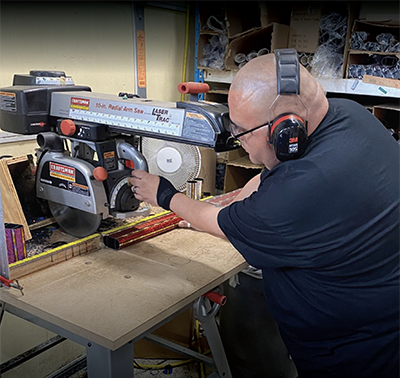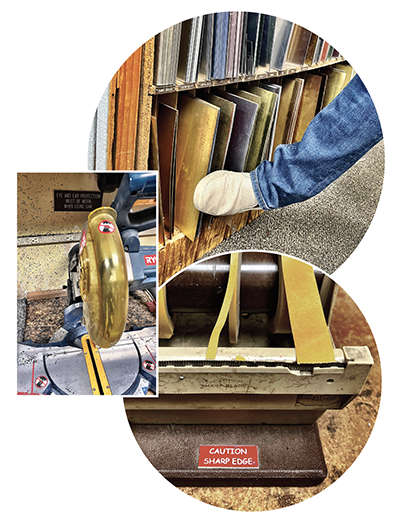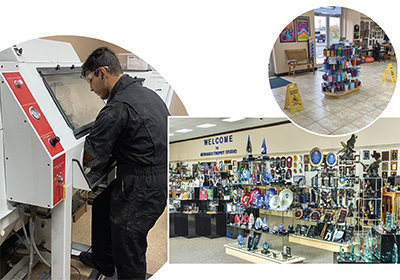There is no historical record, but it’s not hard to imagine: An early ancestor chips away at a piece of flint—and bashes a finger in the process. As long as humans have had tools, we have had to figure out the best ways to use them safely.
Safe and Sound
Making sure everybody stays safe on the job is a top priority.
By: Myrna Traylor
(Originally printed in the July/August 2023 issue of Insights.)
There is no historical record, but it’s not hard to imagine: An early ancestor chips away at a piece of flint—and bashes a finger in the process. As long as humans have had tools, we have had to figure out the best ways to use them safely.

Monarch Trophy Studio's Tomas Martinez using a 10" radial arm saw
These days, the manufacturers, owners and operators in the personalization and awards industry have drawn on a combination of rules, guidelines and experience to keep people safe while they use potentially dangerous equipment and materials. Even though the stakes aren’t necessarily life and death, every business should have established policies to keep everyone as safe as possible.
Covering the Basics
Megan Raymond owns and operates Raymond’s Trophy with her husband in Bakersfield, California. They have a wide array of equipment, including several types of shears (including one from the 1950s), a sandblaster, rotary engravers and two varieties of laser engravers: CO2 and fiber. Each piece of equipment requires attention to detail in its operation—not only to get the desired product output, but to keep the 10-person shop working safely and efficiently.
Raymond also notes that the materials they use must be handled with care. “We keep all of our aluminum and brass on-site. We keep 12-inch by 24-inch sheets underneath where the metal shearers are,” explains Raymond. “When you have to push a piece of metal back into the slot, that could give you a heck of a paper cut. And no matter how many times we say it, we have to remind staffers to put the piece in and then slide it in with their foot. Because of that, everybody here has to wear closed-toe shoes.”

Raymond's Trophy is "hyper-vigilant" about worker safety, including required closed-toe shoes for all employees.
Raymond explains that some new employees look confused when she brings this up initially. “When we first hire people, we always tell them you don’t have to wear steel-toed boots—that’s not required—but you’ve got to wear a closed-toe shoe. And they kind of look at us like we’re weird. I tell them, ‘You’re handling everything here. There isn’t one person that does one thing. Everybody handles everything.’”
Raymond even shared how she sustained a minor injury when she caught her foot on the side of the laser and cut her shin. “That was me being stupid—I wasn’t paying attention. But if I hadn’t had my shoes on, I would have done the same thing on my foot. You feel kind of silly when you’re the person who’s supposed to be setting the example, and then you’re working fast, or you’re not paying attention, and something bad happens.”
Thankfully, that sort of thing doesn’t happen very often. Raymond says she has to be “hyper-vigilant” about worker safety because California’s Occupational Safety and Health Administration (OSHA) regulations are fairly stringent—even though trophy workshops don’t fall into a category with specific rules. Nevertheless, Raymond ensures each of her employees gets a policy and procedures manual when they start working for the business and instruction on each piece of equipment.
Safety at Scale
Monarch Trophy Studio in San Antonio, Texas, has been owned and operated by Charlie and Kathy Drago since 2000, when they purchased it from the original owners, John and Sandra Bradley. The small “regular trophy store,” as Charlie puts it, began in 1972. The Dragos turned it into a massive business, building a new 6,000-square-foot retail space fronting a 25,000-square-foot workshop in 2012. The couple’s eldest son, CJ, is now president of the 180-person company.
Outfitted with a battalion of engravers, sandblasters and 50 lasers, Charlie says that they have “pretty much everything that’s in the industry. And we don’t have one of anything because we’re too big. If it breaks, it’s no good. There’s two of everything, just in case.”
Like Raymond, Charlie has safety procedures and policies for employees—they are just performed at a different scale. “We’re fortunate because we have an HR department, which is probably rare in the trophy industry because [most others] don’t have this many employees,” says Charlie. “When new people come in, they go through an HR orientation and get assigned to a person they shadow. That person teaches them what we do and how we do it. And then a couple of times a year, we do safety meetings where we go over things like if there’s a fire, how you get out of here and what to watch for. And we have a general manager who watches over the production, and he makes sure that they’re following the right procedures.”

Monarch's Darrion Hernandez using a sandblasting cabinet and Inside Monarch Trophy Studio
Besides working with individual customers, Monarch has contracts with several large clients that generate enough business for them to run their facility 24 hours a day, five days a week. One of their clients is a publicly held company that requires Monarch to complete yearly safety and performance compliance inspections by a third-party vendor.
“It’s a totally thorough audit, where they come in for a week, and they watch everything: They watch your machines; they test stuff; they check to make sure that you have safety stations, first aid stations, eyewash stations—everything that OSHA would require,” Charlie says. “It’s really burdensome, but it’s also really great because you could feel like you didn’t have time to watch all those things. But if you have an audit and you have to have it all perfect or lose your contract with a big public company, it’s a little easier to stay on top of all that stuff.”
Charlie explains that near the end of the audit process, inspectors give the company four hours to address anything that is not compliant, and the Monarch team fixes it on the spot. Another benefit, he says, is that when Texas OSHA comes around, he can share the completed report with them. “I tell them, ‘Hey, we just completed this compliance audit,’ and they leave us alone because that audit is so thorough, there’s no use in them wasting their time.”
Building in Safety
Personalization and awards shops have a partner in the safety game—equipment manufacturers. Mike Dean, one of the founders of Epilog Laser, points out that safety features are built into their product line.
“Our equipment is considered a class two laser, which means that the laser beam itself is totally enclosed while it’s operating and not humanly accessible while it’s turned on,” Dean says. “There’s not a lot that workers need to do to make the system safe. The systems are electrically grounded, and there are a number of standards that we conform to to make the laser safe to use.”
Of course, users need to follow maintenance guidelines to ensure continued safety. “The only problems that we run into from a safety standpoint,” Dean says, “is that if you don’t keep your machine clean—especially if you’re vector cutting material—there’s potential for the machine to catch fire.” Dean explains that waste debris from large amounts of wood or acrylic that falls below the vector grid can build up over time and become a fire hazard if it is not regularly cleaned out. (Acrylic, being a petroleum-derived material, is very flammable.)
Fortunately, Dean says this is a rare occurrence. Their systems feature two ways to keep the work area clean. The first is to lift the vector grid out and vacuum the debris. The second is to drop down the front panel, remove the “crumb tray” and empty it into the trash.

Alejandra Martinez of Monarch Trophy Studio using a CO2 laser engraver
Additional safety features include a heat-detection system that will shut the laser off if the work area overheats and glass doors that do a better job of containing any fire that does start.
Attention to Detail
Sometimes safety concerns arise because of items that customers bring in. Raymond says that her shop regularly takes in firearms for engraving. She says that she and her husband will usually work with those customers personally. “We are in a huge hunting community, so when we engrave a gun, the first thing I ask them is to show me that it’s unloaded. I don’t touch that firearm until I see that it’s unloaded and there is no bullet in the chamber. That goes for a shotgun or a rifle or a handgun. If you aren’t going to demonstrate proper gun safety just at that moment, I won’t even work with you as a customer.”
Raymond’s Trophy also accepts special requests from law enforcement. “They like to have their handcuffs engraved,” says Raymond. “When we have a new employee, and [an officer] comes in, the first thing I say to my staffer is, ‘You’re not taking them out of this bag until you’re ready to engrave them. Don’t play with them.’ ‘Why?’ ‘Do you have a key?’ ‘Ohhhh—’ ‘Neither do I.’”
Ultimately, safety in the workshop is a concern everyone must share. “This is the thing: If anybody ever says, ‘I want this instead because it makes me feel safer,’ we’ll provide it,” Raymond says. “I have no problem if you want some kind of crazy apparatus to wear while you’re sandblasting because you’re just not comfortable with the silica that blows around. I’m going to give you what I know you need, but if you feel like you need better or think there’s a better way we can do it—because there’s always a better way—then I’m open to that suggestion.”
Read more articles about Laser